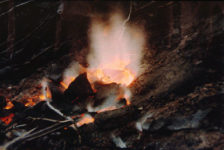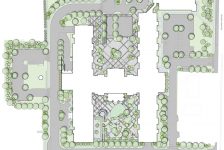Due to being suddenly inundated with design and construction projects I have not been able to post nearly as much as I would like. One thing I would like to share at the moment is an opportunity I recently had to review some materials from Nemetschek’s Vectorworks program. I started using Vectorworks at the beginning of 2009 and thought some of the information might be useful to any professionals in the industry.
There were several reasons why our company made the decision to start working with Vectorworks Landmark. Coming from a AutoCAD and Google Sketchup background, I had been quite used to the traditional work flow with most of the design industry. Typically grading and planting plans would come from a CAD format, and some of the more three dimensional features would be roughly modeled in Sketchup, then typically hand rendered using the models as guides.
While this was often an effective way of communicating our designs, I had always felt that something seemed amiss. The first key issue was the need for redundant drawing lengthening the time spent in the CD/DD phases. Having to use 2-4 programs to create a deliverable package was a relatively tedious process. On top of that, unless you bought specialized versions of AutoCAD software, many of the tools that landscape designers and architects could use were never bundled within the same software package. Yes, programs such as LandFX helped remediate some of the issues but certainly not all. Also, given some of the environmentally sensitive sites that we are accustomed to working on, the ability to model shadows, slopes and drainage as well as create accurate cut and fill calculations were all something that we could use on a regular basis.
After some research we decided to give Nemetschek a call to obtain a trial version of Landmark. While the learning curve was steep mainly due to having to think in different ways than the industry standard work flow, the software seemed to have great potential in our company. SIM and parametric modeling/planning seems to be the current direction that the industry is going. Having complex numerical data associated with all elements within a set of plans or a model (as opposed to Sketchup being primarily graphic with minor abilities to measure area) is an extremely powerful method of control.
I think the biggest ‘wow’ for us was the site modeling capabilities. In Landmark one can create a fully parametric model of the existing site then through the use of special site modifiers, can change elevations, slopes, create terraces, drains etc. Once this is done, you can then compare the changes of volume between the existing site and the proposed one, giving you a theoretically accurate cut/fill ratio. This is extremely useful for creating environmentally sensitive projects and attempting to balance cut and fill creating a net volume change of zero. Another nice feature of the parametric site modeling is the ability to calculate storm water flow directions, as well as color code your site model based on the slope in specific areas (gradient from green to red showing a low slope to a steep one).
Other things that I have come to love is all the data you can associate with your plant symbols. Everything from growth habits, water requirements and even photos can be placed in tables and outputted with your deliverables. Each 2D symbol is also related to the 3D plant models, to make a seamless transition from 2D to 3D model space.
This brings me to the more recent experience with the Vectorworks software. First let me say that Nemetschek has some of the best customer service of any software or technology company that I have ever dealt with. They always seem to be eager to communicate with their customers and help in any way possible. I was recently sent one of their new tutorial books called 3D Modeling in Vectorworks 2009 by Jonathan Pickup to review and give my thoughts. Vectorworks is an extremely versatile VIZ and modeling program, but the learning curve into parametric modeling can be a little daunting. The program allows multiple ways of doing similar things so users can choose which methods they prefer which is very useful, however it can sometimes lead to indecision. Overall I think the new book is a great way to really get into parametric modeling. Pickup outlines various 3D modeling tools, giving tons of screen captures as well as a DVD containing associated videos. After learning some of the basic commands and uses for the tools, the tutorial takes you through a couple of full projects from start to finish. While the methods within the book may not necessarily be the only ways to complete the task, the tutorials will at least give an example and concept of how it is done. For those more experienced with parametrics and 3D modeling (not Sketchup), hopefully a more advanced tutorial will be created in the future to really take advantage of all the features Vectorworks has to offer. Overall I think it would be a valuable resource for anyone interested in creating more complex 3D environments for VIZ or presentation purposes.
It needs to be said I do not work for Nemetschek and I am not on their payroll. Personally I would love to see more companies break out of the traditional work flows and try something that could be both more efficient and worthwhile. More users of Vectorworks means greater user support for the program, which is always invaluable. For any professionals looking at software for their firms, I would strongly suggest at least asking Nemetchek for a copy of Landmark to try out. They seem to be a great group of people with a power product.
-k. vincent
Originally posted at the-veg.com
Published in Blog











Jim Del Carpio
I’m just getting with VW Landmark and after 10+ years of AutoCad, it’s been a challenge to learn a new mode to draw, let alone design with VW. However, from what I seen through Videos and other sources, I believe this type of Program, with SIM capability will be dominant with L.A. Firms.
Ryland Fox
Are people aware that Vectorworks is BIM? Albeit a weak version.
Kellan Vincent
I think also it comes to economics. The time lost for a design firm to implement the switch would most likely be influential. As with learning any new program, it takes time. For a whole company to switch, the productivity across the whole firm would most likely decrease while users learn the new software. This can be a deterrent for companies that tend to be a little nearsighted when it comes to fiscal management.
Daryn Fair
Vectorworks has been very supportive of the LA profession and making a strong presence in the market. I had the opportunity to sit through one of the free trainings they offered at the Annual Meeting this year in Chicago. I found the program to be adaptive and time saving in comparison to standard ACAD program I have been using. When I looked around the at the show, I did not see anyone else that even compared to what Vectorworks Landmark offered. They were also very receptive to feedback and are seeing steady growth. BIM technology is here to stay and I am anxious to learn more about the new 2010 release. Would love to hear what new users are experiencing.
Grant Beerling
Kellan, in your opinion would you say the programme is intuitive (as a dyslexic mac user its a great help when similar logical paths are followed) or is it like AutoCAD? (i.e. 5 different ways to do everything thus confusing for those with a short term memory or occasional use).
Thanks for the Review, starting on Vector this winter, can’t put it off any longer.
Grant
Kellan Vincent
Grant, to field your questions.
To me, this is one of those questions to which I would like to answer “both”, but I will try to refrain. There are many ways to do similar things in VW without a doubt. In 2D, options are a little less. As long as you learn to control layers and classes, designing and planting is pretty straight forward. The polyline tool can provide a large portion of your created shapes and can be converted to a variety of different objects (site modifiers, surfaces, hardscapes etc). Personally I use a lot of add/clip surfaces to create the shapes and patterns I want. While you can almost use VW almost like adobe illustrator, creating a graphically nice plan, the program’s potential is not realized until you start combining 3D aspects with your plans. With 3D modeling you can extrude or sweep 2D shapes or you can work strictly with NURB surfaces and curves. The site modeling capabilities are tremendous, especially once you get the hang of site modifiers.
Over all, I would say that Landmark is definitely more intuitive than AutoCAD, with a very powerful tool set. A lot of the custom scripts or add-ons with AutoCAD are part of the native program on VW. That being said, there is a LOT of potential to develop your own style and work flow. Until Pickup’s book, I was doing a lot of my alignment, moving, and distribution “free hand”, aligning stuff visually, rather than some of the built in parametric tools. The flexibility of Vw really helps get a very specific end result, with a large variety of slightly different and complimentary tools.
Really, it comes down to just using the program and see if any of the possible work flows are compatible with you. I think part of the “non-intuitive” nature that leads to steep learning curves with some is just the fact that it is unlike many of the comparable design software options, not following a strict AutoCAD type format. This doesnt give many people a basis of experience, which often helps with new software. From what I have seen however, the available tutorial books and sessions can be a major help. When starting out I took part in a webinar from our own Eric Gilbey which really gave me an idea on how to use the program.
Good luck with learning the program! Stick with it and I’m sure you will wonder why you used anything else.